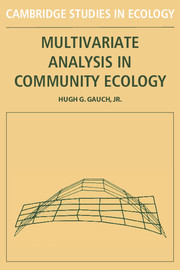Appendix: Available computer programs
Published online by Cambridge University Press: 05 August 2012
Summary
Multivariate analyses routinely require millions of mathematical steps and hence necessitate solution by computers. The algorithms are often complex, however, requiring mathematical and computing expertise for programming them and sometimes many weeks of programming labor. Consequently, the development of computer programs for multivariate analysis has occurred mainly at a relatively small number of laboratories, and the programs are distributed to numerous other laboratories. This Appendix will list several sources of computer programs for multivariate analysis of community data.
The Cornell Ecology Program, series, edited by the author, is perhaps the most widely used package, having been used in hundreds of laboratories in over 30 countries. Information on these programs is available upon request from the author. All programs are written in FORTRAN. Several of the commonly used programs are as follows: ORDIFLEX, a flexible ordination program performing weighted averages, polar ordination, principal components analysis, and reciprocal averaging; DECORANA, providing reciprocal averaging and detrended correspondence analysis ordinations; TWINSPAN, producing hierarchical classifications by two-way indicator species analysis; COMPCLUS, performing nonhierarchical classifications by composite clustering; DATAEDIT, offering a variety of data–matrix-editing options, along the lines discussed in Chapter 6; and CONDENSE, a utility program for reading data matrices keypunched in a wide variety of convenient formats and copying them into a single standardized format efficient for computer processing. There are additional programs, including one for Gaussian ordination and two for simulating community data.
Information
- Type
- Chapter
- Information
- Multivariate Analysis in Community Ecology , pp. 246 - 247Publisher: Cambridge University PressPrint publication year: 1982
